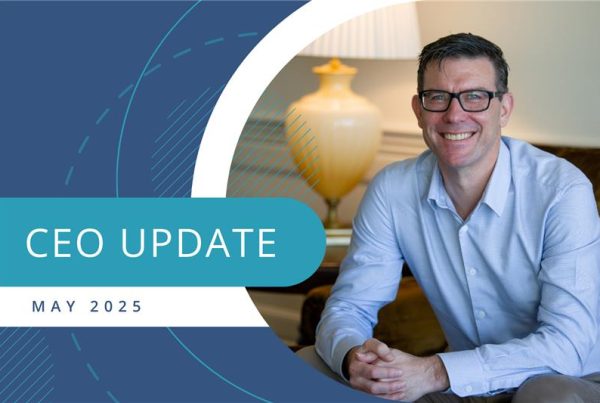
There are more than 2.2 million property investors in Australia, according to the most recent data1 from the Australian Taxation Office. The main reason property investment is so popular is because it’s helped many people build wealth over the years. The combination of capital growth and rental income – magnified by leverage – can produce strong long-term returns.
But real estate investing, like any form of investing, is not all upside. Buying an investment property is more difficult than acquiring shares. Also, if you choose the wrong property investment strategy, or choose the right real estate investment strategy but err with the execution, you might experience low or even negative returns.
With that in mind, here are 10 steps to follow if you want to successfully add real estate assets to your investment portfolio.
1. Establish your goals
Before diving into investment property research, take the time to define your wealth and life goals. Your investment strategy should be tailored to these objectives, as a strategy that works for one goal may not align with another.
Think of it like planning a journey — you need to know your destination before mapping the most direct route. A path that leads to one destination won’t necessarily take you to another. Clear goals provide direction and ensure your strategy stays aligned with where you want to go.
2. Select a real estate investing strategy
Once you know where you want to go, you need to decide how – by what path – to get there.
Your choice of strategy will influence not only the value of the property you buy, but also the type of property and the location.
For example, some properties (such as houses located in the major capital cities) tend to produce higher capital growth and lower rental yield, while other real estate assets (such as units or those located in regional areas) tend to produce lower price growth but can deliver higher rental yields.
Your choice of strategy will also influence the structure in which you purchase the property, your loan-to-value ratio and the method you use to pay the deposit (whether using cash or borrowing against equity in your owner-occupied home).
3. Choose between direct investment and co-investment
As part of the strategy discussion, you’ll have to decide whether to invest directly (i.e. purchase the property on your own); co-invest with a partner, relative or friend; or invest into a residential property fund. These funds do the leg-work for investors, in terms of finding properties to invest and conducting due diligence on the assets. Depending on the fund’s strategy, they may work with owner-occupiers through a co-investment model or tenant properties and collect rental income.
4. Assess your finances
As part of the process of establishing your goals and selecting a strategy, you should get clear on your finances. That means understanding your assets, liabilities, income and expenses – both now and in the years ahead. For example, if a member of your household was planning to leave the workforce for a couple of years to have a baby, that would affect your future income. On the other hand, if you identified ways to reduce your living costs, that would improve your expenses.
The stronger your finances, the more creditworthy you’ll be in the eyes of lenders. That will produce a triple dividend – you’ll find it easier to qualify for a loan, you’ll have a higher borrowing capacity and you’ll be more likely to be offered a lower interest rate.
5. Consider getting professional help
One of the most common pieces of advice experienced property investors give when asked how to invest in residential real estate is to consult experts. That may include:
- Financial adviser – to help you determine the right investment strategy.
- Mortgage broker – to help you find a competitive home loan and choose a suitable loan structure.
- Buyer’s agent – to help you identify a quality investment location and then acquire a quality investment property.
- Conveyancer – to help you review the contract of sale and manage the transfer of ownership.
- Property manager – to help you secure good tenants, collect the rental income and maintain the property.
While this property investment advice comes at a cost, it means you’re less likely to make expensive mistakes and more likely to make profitable decisions.
6. Research different property markets
If you appoint a buyer’s agent, they will research potential property investment locations for you, including those in different states; if you don’t, you will have to do this research yourself. In that case, you should try to form a view of each location’s demand and supply factors, for both now and the future.
Demand factors may include:
- Days on market – How long is the average property taking to sell? And are days on market trending up or down? Those two data points will help you assess the strength of local buyer demand.
- Asking prices – Are vendors raising their asking prices or lowering them? And at what rate? Those metrics will provide more insight into the state of the local market.
- Local economy – Generally, people want to live in areas of strong employment, so the more jobs a location has, the more in-demand it’s likely to be among both owners and renters. It’s also important to assess the diversity of the local economy, because if a location is dependent on one industry (such as resources) and that industry suffers a downturn (such as the local mine closing), property demand would probably suffer too.
- Crime rate – Study police statistics to find out what the local crime rate is, how it compares to other locations and whether the level of crime is trending up or down.
- Population growth – Find out how fast the population is growing in both absolute terms and compared to other locations.
- Amenities – What currently exists and what’s in the pipeline?
- Infrastructure – What currently exists and what’s in the pipeline?
- Demographics – It’s also worth researching the make-up of the current population and comparing them with the demographics of new residents, because that could affect future development. For example, if the suburb has a lot of families but many of the new residents are singles, that may change the type of housing that gets built. If the suburb has a disproportionately high number of older people but many of the newcomers are younger, that may affect the kinds of amenities that get built.
- Natural disasters – The more prone a location is to floods, bushfires and cyclones, the less long-term demand it will experience.
Supply factors may include:
- Inventory levels – This metric tells you how many months of stock are on the market, assuming properties keep selling at the same rate. When inventory levels are low, buyer demand is strong; when they’re high, it’s weak. The trend is also important, as that indicates whether buy demand is rising or falling.
- Vacancy rates – This metric tells you the share of untenanted rental properties in the local market. A low vacancy rate means the market is undersupplied; a high vacancy rate means it’s oversupplied. Again, the trend is important.
- Residential construction – How many homes are being built right now? And what type of properties are they (e.g. houses, townhouses, units)? This will give you an insight into how the local housing supply will change in the short-term.
- Building approvals – How many homes have been approved for construction? And what type? This will help you understand the medium-term outlook.
7. Conduct due diligence
It’s generally a good idea to order a building inspection and a pest inspection, so you can identify any hidden structural problems and pest infestations.
If you’re buying an investment property in a strata complex, it’s generally a good idea to order a copy of the strata report as well. That will reveal the condition of the building and common areas, the by-laws and rules of the complex, the financial position of the owners’ corporation and whether there are any ongoing legal disputes involving the residents or strata scheme.
8. Understand the risks of real estate investing
Identifying the potential risks gives you the opportunity to implement measures that will reduce the chance of those bad things occurring and minimising the impact if they do.
Potential risks and responses may include:
- Rising interest rates – Many people reduce their expenses in the lead-up to a home loan application to increase their chances of being approved. If you continue to minimise your expenses after you buy the property, you should be able to handle any rate rises.
- Job loss – You might struggle to make your mortgage repayments if you lose your job or suffer an injury that forces you to leave the workforce. You can guard against these risks by taking out mortgage protection insurance.
- Falling property prices – This would be an issue if you were forced to sell during a downturn. By protecting yourself against rising interest rates and job loss, you should also protect yourself against being a forced seller.
- Rental vacancy – Appointing an experienced property manager who understands the local property market and has a database of tenants will reduce the risk of your property being unfilled.
- Falling rental income – An experienced property manager will also reduce your risk of under pricing your property.
- Tenant problems – Taking out landlord insurance will cover you if tenants don’t pay their rent, while building insurance will cover you if they damage your property.
9. Establish and maintain buffers
While it might be tempting to pour all your savings into a larger deposit to secure a higher-value investment property, doing so could leave you financially exposed. Without a buffer, unexpected personal expenses (like medical bills) or property-related costs (like a burst hot water system) can quickly strain your finances.
To safeguard against these risks, many experts recommend maintaining savings equal to at least six months’ worth of both personal living expenses and property-related expenses. This buffer not only provides peace of mind but also ensures you’re better equipped to weather financial surprises throughout your investment journey.
10. Plan next steps to maximise your real estate investments
Depending on your strategy, buying an investment property might be just one step towards achieving your goals rather than the only step you need to take.
In that case, once your purchase has been completed, you should start thinking about your next move, which might include anything from adding a granny flat to your existing property to saving up to buy more real estate assets.
Property Investment with HOPE Housing: A Simpler, Smarter Alternative
Buying an investment property can be complex, costly, and time-consuming. From setting goals and selecting a strategy to arranging finance, researching markets, and managing ongoing property upkeep — it’s clear that property investing requires significant effort and expertise.
But what if there were a way to access the benefits of property investment without all the hassle? That’s where HOPE Housing comes in.
Through its second fund, HOPE Fund II, HOPE Housing offers a unique co-investment model that allows wholesale investors to gain exposure to the property market without the burden of direct ownership. Instead of managing individual properties, investors partner with essential workers — like nurses, cleaners, and first responders — to co-own residential properties.
Here’s how it works:
- Shared Responsibility: Essential workers buy into a property with their own funds and mortgage, while HOPE Fund II makes an equity co-investment alongside them. This shared commitment reduces risk and aligns incentives for all parties.
- No Upfront or Ongoing Costs: Unlike direct property investment, HOPE Fund II investors don’t pay for stamp duty, conveyancing, council rates, land tax, or insurance — these costs are fully covered by the owner-occupiers.
- Capital Growth Without the Legwork: HOPE Fund II investors can earn capital growth on the Fund’s share of each property. Each investment is vetted through an independent investment committee process, with pre-purchase valuations, inspections, and legal reviews to ensure quality properties are acquired.
Why HOPE Fund II is a Better Way to Invest
Unlike traditional property investment, HOPE Fund II can allow you to build wealth through property without the stress of tenant management, maintenance, or navigating the buying process. You can access professional due diligence, diversification across multiple properties, and a socially impactful way to invest.
For essential workers, it provides a pathway to homeownership in areas close to work, supporting job retention and community stability. For investors, it offers a hands-off, more cost-efficient route to property returns with built-in social impact.
If you’re looking for a simpler way to invest in property, with no upfront costs, no ongoing management, and the potential for strong returns, HOPE Housing is a smarter alternative.
(A) Portfolio growth is determined by estimating market value of the properties within the Fund’s portfolio monthly, using CoreLogic IntelliVal (Automated Valuation Estimate) and PropTrack AVM. The change in total portfolio value is indexed from a base value of 100, established at the inception of the Fund’s portfolio, to account for the addition of new properties during the same period. The 12-month growth represents the cumulative growth over the prior four quarters. The portfolio growth information does not take into account liabilities or expenses of the Fund and therefore may not reflect overall Fund performance.
Disclaimer
Past performance is not a reliable indicator of future performance.
The information in this article was finalised in December 2024.
The article has been prepared by HOPE Housing Fund Management Limited ACN 629 589 939 (Investment Manager/Manager/Company/HOPE/HOPE Housing) directed to wholesale clients and is strictly for general information and discussion purposes only, without taking into account your personal objectives, financial situation or needs. Before acting on this general information, you must consider its appropriateness having regard to your own objectives, financial situation and needs. The information provided is not intended to replace or serve as a substitute for any accounting, tax or other professional advice, consultation or service and nothing in this article shall be construed as a solicitation to buy or sell any financial product, or to engage in or refrain from engaging in any transaction.
Prospective investors should carefully review HOPE Fund II’s Information Memorandum (IM) in full and seek professional advice prior to making any investment decision. For more information about the Fund, please refer to the Investor Disclaimer on our website.




